A little sketch book for AHO's course in interaction design 2022, made by Dora
Don't wanna be here? Send us removal request.
Text

Result
A video explaining and demonstrating our project.
Affiliates
@williamdalsto @gyllenstendesign
2 notes
·
View notes
Text

Lesson plan
As per the brief, the learning experience will ultimately happen inside a classroom, meaning it will be incorporated into a school module, even though we were not required to heed any of official learning outcomes on UDIR or elsewhere in our design. Meaning we will have to consider our learning experience within the confines of a lesson plan.
Bringing it all together, the lesson begins with an introduction to the overarching concept and some general rules which applies to both the analogue and digital games. Afterwards, the class is split in half: Team Analogue and Team Digital, where the teacher will quickly brief the students on the narrative. Then each team is split in two yet again: one group will be defusing the bomb, while the other group has access to the bomb manual which they have to decode. After 25 minutes, the team will have the opportunity to switch games, so that both teams gets to experience both the analogue and digital bomb. After yet another 25 minutes, the two teams are disbanded, returning to being a class as a whole. The teacher then gives the students some prompts to make them reflect on the experience and how it applies to their lives as a whole beyond the classroom.
Pedagogical theories
Vygotskys proximal learning zone.
Reflection
During playtesting we experienced that engagement dropped in the first and last part of the lesson, because it followed a traditional lecture format. An interesting iteration on the lesson plan would be to try incorporating the reflection prompts into the game itself, in attempt to circumvent the traditional teacher-student lecture dynamic.
Affiliates
@williamdalsto @gyllenstendesign
2 notes
·
View notes
Text

Communication modes
The key aspect of our concept is the communication happening between the bomb defusers and bomb manual decoders.
Team Analogue
We made a thread track device to simulate snailmail. How slow physical communication is and thus how deliberate one has to be in what information one sends.
Notifications with a honking horn.
They are only allowed to communicate through drawings.
Team digital
We handed the students our smartphones to communicate with.
Students cannot communicate in Norwegian.
The students are allowed to arrange for what kind of code language they wish to use.
Affiliates
@gyllenstendesign @williamdalsto
3 notes
·
View notes
Text

Bomb manual
The second part of our concept was the bomb manual which holds the key to defusing the bomb, hidden in encrypted puzzles.
Although not the primary feature of our design, it was inspired by escape room puzzles.
Analogue puzzles
Professor Rumlegås has gone missing! Homemade sketchy aesthetic.
Digital puzzles
Google street map
Inspect wikpedia page — make the students feel like real hackers
Code hidden in console of a webpage
USB disk containing various files
Ctrl f through a faux vg front page
Prowling through suspicious posts in a social media hashtag
Visiting the internet web archived page of a dead link website
Looking for hidden messages in the web search history of a web browser
Looking through a youtube video for recurring iconography
Listening for morse in an audio file or blinking lights
An idea was to make the students plug in their phone to the computer with a USB cable for narrative immersion.
Affiliates
@gyllenstendesign @williamdalsto
2 notes
·
View notes
Text

Digital bomb
We unfortunately didn’t achieve as high finish on the digital bomb as we did on the analogue bomb. We originally planned to make the digital bomb into an actual interactive website, but our teacher urged us to stick to Figma, since that’d make it easier to iterate our design.
In hindsight, we should have been more stubborn about following our original plan, because all the pupils figured out they could cheat by pressing the arrow keys, instead of actually doing the escape room puzzles to properly defuse the bomb.
Narrative
The narrative of the digital game was that the police have arrested some members of a hacker group who have created a virus bomb that will publish all the pictures on their phones, essentially «face raping» the players as it’s called, unless they defuse the bomb.
Visual design
For ease of iteration we initially decided on a simple flat UI look, although we later on also played with the idea of adding a more hacker aesthetic through the use of binary, ASCII art, 1337 hackerspeak, and hiding the answers inside of actual javascript code.
Coding
Although unfinished, this is what the plan for the code was.
Nb!!! This post is a work in progress!
Affiliates
@williamdalsto @gyllenstendesign
2 notes
·
View notes
Text

Analogue «bomb» with Arduino
Making the physical bomb was a challenging and very rewarding experience. It’s created with Arduino placed in a suitcase. None in the group had ever touched Arduino before, and we only had one person who had a little experience with MicroBit, so huge props to @gyllenstendesign for figuring it out in the end!


Arduino
Since we had no experience with Arduino, we scoured the internet for tutorials. Initially we wanted to recreate this bomb made by Alastair Aitchison, but we unfortunately didn’t have the same exact materials that he used, and trying to adapt the code to fit the materials we did have would be too over-ambitious for this project. Therefore our quest continued for a tutorial that fit the electronics we had on hand. Eventually we began looking through GitHub and discovered this tutorial made by Raphaël Champeimont, which is what we ended up using in the end. We even got in touch with the creator, who helped us figure stuff out.


Suitcase
After the "guts" was settled, we began working on the "shell". We bought a suitcase off Finn.no, and created a wooden mount to place the electronics on. One challenge was that the breadboard we used had already been taped onto a lasercut frame by the people we purchased it from, so some of the wires which were not supposed to be cut were unfortunately visible. To signal to the players that these wires should be left alone, we wrote a note in the suitcase and color coded these wires black and red. Meanwhile the wires that should be cut, we made colorful and wrote a note telling the players that these wires could be cut.
To add to the narrative, we filled a soda bottle with green soap water and pasted a sticker on it to make it look like a biohazard bomb. We also used some gold and black striped tape, which added to the narrative flair.

Reflection
Given more time, we could have tried out connecting our bomb to a speaker, and thus added sound effects like the final explosion and the ticking countdown timer, which could make the game more responsive to user input.
As for the suitcase, we could have tried getting our hands on another breadboard, which would have allowed us to hide the guts fully underneath the "shell". Or even better, we could have gotten to actually solder everything together. Although we tried to avoid permanently soldering anything, because we wanted to preserve the parts for use in future projects.
We also had a little fun talking about glitter bombs when ideating the analogue bomb, and talked about maybe creating a confetti explosion. Since an actual glitter bomb is a bit much, and having glitter stuck everywhere forever probably wouldn’t be very popular with the people who has to clean it up.
Affiliates
@gyllenstendesign @williamdalsto
#brief 9#game design#arduino#bomb game#escape room#ahoexploringinteractions#ahoexploringinteractions2022#process
5 notes
·
View notes
Text


Norwegian Museum of Science and Tehnology (TM)
The project began with a preliminary visit to the new I/O exhibition at the Norwegian Museum of Science and Technology, for which we were tasked with designing an interactive learning experience for middle schoolers.
The exhibition uses
Wandering the exhibition, we were struck by how much we missed the software inside the different electronical appliances in the exhibition. For instance, what does a smart home device from the 70s sound like? What was it like to use flip cellphones? How would it blink and beep? How does a home assistance robot from the 80s behave? How did the operating system on the first apple computer look like and behave? What was the actual interaction between the user and the interface like way back when?
Conclusion
After drafting and brain storming some ideas on small A6 pieces of paper, we decided on communication as the theme of our project. Our idea is to convey how different communication channels influences how we express ourselves and how much we decide to share. Especially the contrast between the information overload from instantaneous smart phone messaging and the slow mode of written letter mail (also endearlingly called snail mail), which illustrates the revolutionary age of information we live in.
#brief 9#process#site visit#teknisk museum#exhibition#science#technology#history#ahoexploringinteractions#ahoexploringinteractions2022#tele-communication#communication
1 note
·
View note
Text

Brief 8
A timeline / slideshow showcasing one animal meme for each year between 2022 and 2008. The webpage is available on Netlify, and the code can be downloaded off of github.
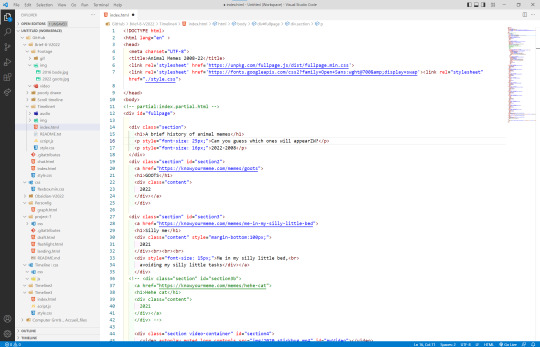
This project has taught me different ways to add multimedia files to a webpage, and how to use a video as a background image. I've also learnt how to create an external button to play an audio file with JavaScript, though I'm still working on figuring out how to make a toggle / pause button for looping audio. I've also had the opportunity to become more familiar with jquery, which quite a lot of tutorials out there have mentioned, though it still feels like a big can of worms.
For this project, I have been working in Visual Studio Code and CodePen instead of Atom, to allow for real-time collaboration, because Atom's servers are down and so the necessary extensions for this could not be downloaded.

Target device format: Landscape computer screen, evt. a TV screen.
1 note
·
View note
Text

Brief 7
A short webpage about me. During this project, I also touched JavaScript for the first time. You can view the webpage on Netlify.

I decided to try working in Visual Studio Code, in preparation for upcoming group work where collaboration extensions are needed, because Atom's servers were down.

Recommended extensions
Some extensions I've discovered, and which might be helpful for others:
Live Server will automatically refresh the previewed webpage, once either the html, css or js files are saved.
Live Share allows you and a collaborator to work simultaneously on the same code folder, editing the same document in real time like in Google Docs. Though there's some aspects that could be improved, but it'll do for now.
Icons will add a icon next to the files in the vscode explorer panel, according to the filetype. This makes it easier to differentiate all the files in the list, as the project grows larger and more complex.
Pigments will preview the colors used inside the editor, and adding a color picker next to it, which makes it easier to choose the desired color combinations.
CSS peek creates a pop-up of the css class in the html editor, if you hold ctrl and hover over the class.

HTML CSS Support will display a pop-up with a list of class names that have been defined in the css document, and which you can reuse here.
2 notes
·
View notes
Video
Brief 6 Playful Interaction - Figma
Our 3rd and the last assignment in this Playful Interaction course or Urban Play. A part of the final playtests project is about create an urban game with a screen companion design on Figma.

This post is in process….
#ahoexploringinteractions2022#ahoexploringinteractions#brief 6#brief 6c#urban game#urban play#game design#pervasive games
5 notes
·
View notes
Text
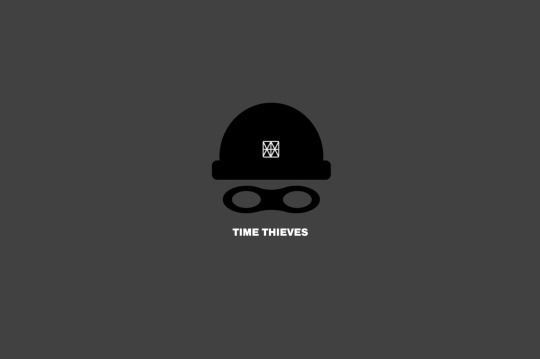
Thematic flavouring
A part of the brief was to display a sense of fiction in the final playtest.
Title
We decided on the name "Dès Vu" for the game, as borrowed from French. It's related to dejavu, but means "The Awareness That This Will Become A Memory" according to the Dictionary of Obscure Sorrows.
As group 4, we've had to work with the assigned theme of "time travel," thus we thought this title was fitting. In John Koenig's words:
"One day you’ll remember this moment, and it’ll mean something very different. (…) So you try to sense it ahead of time, looking for clues, as if you're walking through the memory while it's still happening, feeling for all the world like a time traveler.
The thought behind this title is that throughout the game, you accumulate an amount of selfies. Once the game has ended, the feed you and your friends have collectively created will serve as a time capsule of that place and event in that moment in time, which you can look back upon. As Koenig says, you become "two people, still seperated by an ocean of time. Part of you bursting to talk about what you saw, part of you longing to tell you what it all means."
youtube
Narrative
As group 4, we were assigned the theme time travel. This is something we've tried to incorporate that by basing our story on the 2011 sci-fi action film In Time, were the currency is literally time and thus if you run out of money you actually die, which enables some people to live forever if only they're rich enough. I have attached the trailer below, if you're interesting in having a closer look at this sci-fi story's gimmick.
We borrowed this gimmick in our narrative, and added our own plot to give the players a motivation. Our premise is that the player are time thieves, who wander the halls earning or borrowing time from the different stalls around you, while trying to sabotage other players by stealing their time.
I'm a little bit concerned about whether or not the player will experience a cognitive dissonance between the mechanics and narrative, i.e. between what they do and the motivation they're given, but I hope they have fun regardless.
youtube
Visual identity
As for our visual identity, we've decided to go for a warm hand-made accent in line with Koenig: "Some details are charming and dated," which underlies the mundane point of the game and shift the focus a bit away from the assassination mechanic a bit.
Affiliates
Group 4: @paweetida @evahoybakk @designavva

Affiliates
Group 4: @paweetida @evahoybakk @designavva
#Youtube#ahoexploringinteractions2022#ahoexploringinteractions#brief 6#brief 6c#urban game#urban play#game design#pervasive games#work in progress
1 note
·
View note
Text
Documenting the playtest was challenging, because we can't ensure smooth camera movement while having to run after the players and catch their experience. Ultimately, I ended up just filming them disappear into the distance, and then run after them again. But more often than not I'd lose the player in the crowd, and ended up having to film another player who I met upon instead. This was to ensure that we wouldn't end up with all jittery footage, but I ended up having to resort to the fact that "some footage is better than no footage".
To remedy this, we could have used a GoPro, but then we'd only see the players' POV and yet miss the interaction between them which is the vital part of the experience. The ideal solution would be to use a steadycam rig or another camera stabilizer tool/accessory, which would minimize the jitter or wiggling that happens while moving quickly with a camera. As a compromise we could also have filmed with a stabilizer app.
We also tried to record a birdseye POV, but this was challenging in Mathallen because of the several "canopies" hiding the "streets" on the ground floor. Although this maze-like structure is also one of the reasons why we chose to host the game at Mathallen.
FINAL PLAYTEST: Video documentation
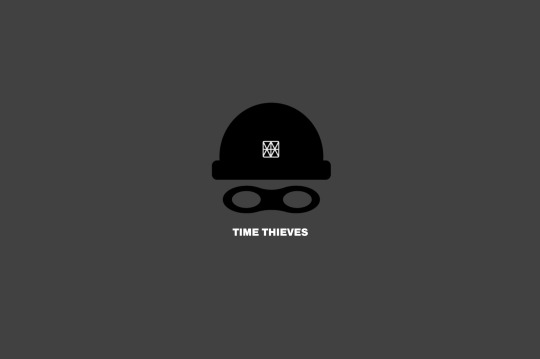
youtube
Group 4: @evahoybakk @paweetida @sandt22
FEEDBACK/THOUGHTS:
The players found the game fun and actually wanted to continue playing the game, which is a good sign!
We tried to influence the pace of the game, but it was difficult without an actual app, because our prompts would drown in the feed (messenger). This was made up for due to the players competitive instinct.
The players had problem remembering which card they had flipped, aka which mission they had already looked at.
Some of the players did not have the Figma app or didn't have charge their phone enough, which made it complicated to playtest. We had to lend players our own phones, which made I complicated for us teens we had an active role as gamemasters.
Its really fun to have a video of the game, but we didn't know where the players would go next, which made I difficult for smooth camera movements.
Every playtest is very different because the game is created by the interactions between the players not a charted course designed by us, which makes filming a natural playtest without staging it before hand.
The employees at "Mathallen" did take notice of the game but contrary what we were feared they were curious and friendly about our activities, asking what we were doing with a smile.
Thanks to the players, @andypracticingdesign @designinginprogress @lexlothe @heyjonna and the Einar @ahoexploringinteractions2022
Congratulations to @andypracticingdesign who won!
#result#ahoexploringinteractions2022#ahoexploringinteractions#brief 6#brief 6c#urban game#urban play#game design#pervasive games
4 notes
·
View notes
Text


We've been working on our pervasive game in Mathallen. I'm excited to see where this is going! Regardless, this is our progress so far!

Game mechanics
We've tried to keep the game mechanics fairly simple throughout the project. But the main idea from the beginning has been to use the smartphone's camera function, either to complete photo challenges or to "hunt" each other in an elaborate game of tag.
Our pervasive game primarily has two layers: First, the players walk around Mathallen searching for the image clues, and take a picture of the clue once discovered.
It's been challenging to playtest since we're unable to make a real working app to make the gameplay flow more easily, and had to rely on messaging apps like Messenger.
This is in attempt to shift the focus a little bit away from the PVP aspect, and onto the more mundane aspect of collecting images, which the majority of life in the film is about: Working. This shift will also hopefully help with the general issue with assassination games like Killer, which is that the best strategy to win the game is to simply hide. The collecting task also encourages players to not hide, which will increase player interactions and duels.
We've also decided that the gameplay should focus around taking selfies, in order to make sniping more challenging. Furthermore we're a bit on the fence about zooming, though we think that a little zooming is allowed.
When it comes to PVP faceoffs, any selfie with the target counts, as long as the target is recognizable in the image.
The score is settled once the game ends, when all the players gather to judge which images count as a point. Each image task should count as 1 point, while each snipe should count as -1 point to the target.
Because we wanted to host the game in a crowded space, we wanted to use something less tangible than a toy weapon which is common in campus' assassin's guilds, and we settled on the smartphone camera. We wanted to do this, in order to not disturb strangers who are not aware of the game taking place, which could in the worst case lead to the players accidentally damaging property or being thrown out of the building. The idea of the camera as a weapon was inspired by the video game Fatal Frame.
Spatial design
In terms of spatial design, we always knew we wanted to host the game in a crowded environment. A crowd will allow the players to blend in with the environments easier, and move around incognito. This mechanic is inspired by the Ubisoft video game Assassin's Creed (AC2), which in turn may be inspired by real psychology or illusions where pickpockets and magician's tricks use sleight-of-hand to steal an item without the target noticing through the art of misdirection, or what spies do when tailing or being tailed by somebody by using disguises.
We also considered staging our predefined game in Karl Johan, because this street is infamously crowded most of the time, but had to abandon the idea because the site was a little further than a 10 min walk away from the university building. We settled for the next best spot, Mathallen, which is probably the most crowded spot within a 10 min radius of AHO. Ideally, we would host the game at IKEA however, where players can hide in the different furniture exhibitions and blend in with the crowd. What these different sites have in common is their floor plan's maze like layout or structure, with plenty of distractions at every corner whether that'd be signs or mundane activities, with small pockets of space to hide in, whether that'd be shops or exhibitions.
From the beginning we also decided that the playground should not be too big, so that the players simply hide throughout the entire game, but not so small that the players cannot slip away without being noticed all the time.
youtube
Sound design
Because this is an assassination-style game, we've wanted to keep the sounds coming from the app to a minimum, to allow the player to blend into their surroundings more naturally and allow them to avoid detection. Instead the focus of the sounds comes from the actual real life environments, such as the bustling of the crowd, clinging and clanging of cooking utensils, and strangers dining and wandering.
If we could make an actual app, we considered adding an alarm sound warning the player that he is leaving the defined playground.
Adaptability
For this prototype, the image targets are pre-defined by us (the game designers), but an idea has also been to allow the players to collectively decide the size of the playground and image targets themselves. For instance, before the game begins, the players could each be tasked to photograph around 3-5 images, which will be sent to the other players. They would also be able to define the size of the playground by discussing amongst themselves, in the same manner that kids design their own child-initiated "games" in the playground or when they play around in general.
Individual player's journey
We begin the game by explaining the rules to the players, before letting them loose for up to 15 minutes, collecting and assassinating each other.
Multiplayer interactions
Linear progression
Affiliates
Group 4: @paweetida @evahoybakk @designavva
#Youtube#ahoexploringinteractions2022#ahoexploringinteractions#brief 6#brief 6c#urban game#urban play#game design#pervasive games#work in progress
3 notes
·
View notes
Text


Internal Playtest 2.0
We gave it another go outdoors this time, since Mathallen is closed on Mondays, and with a GM. The GM merely gave text prompts they could think of made on the spot this time, which resulted in more interesting mission answers than the very specific items in Mathallen. There wasn't a lot of PVP this time however, since there are almost no opportunities to hide in a flat, rather deserted park.
#playtest#test#ahoexploringinteractions2022#ahoexploringinteractions#brief 6#brief 6c#urban game#urban play#game design#pervasive games
1 note
·
View note
Text
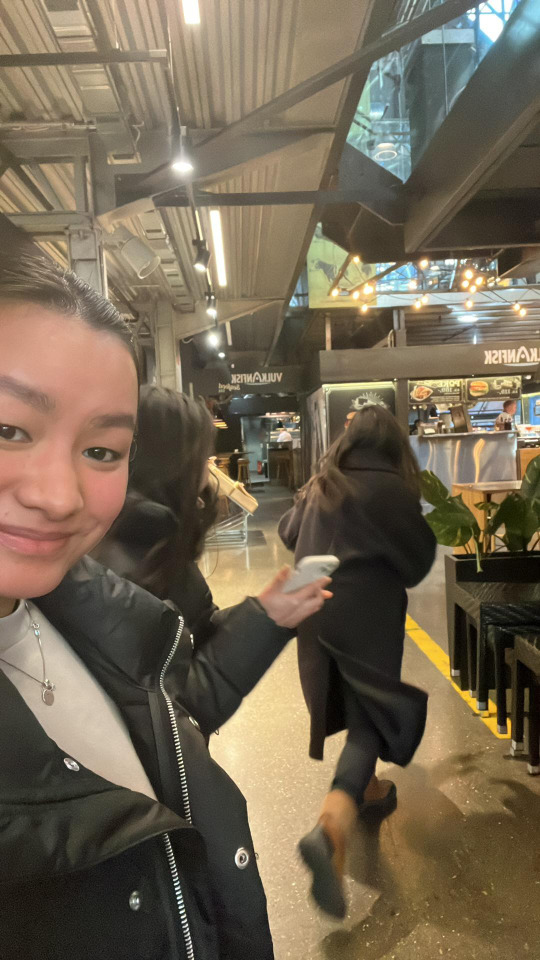
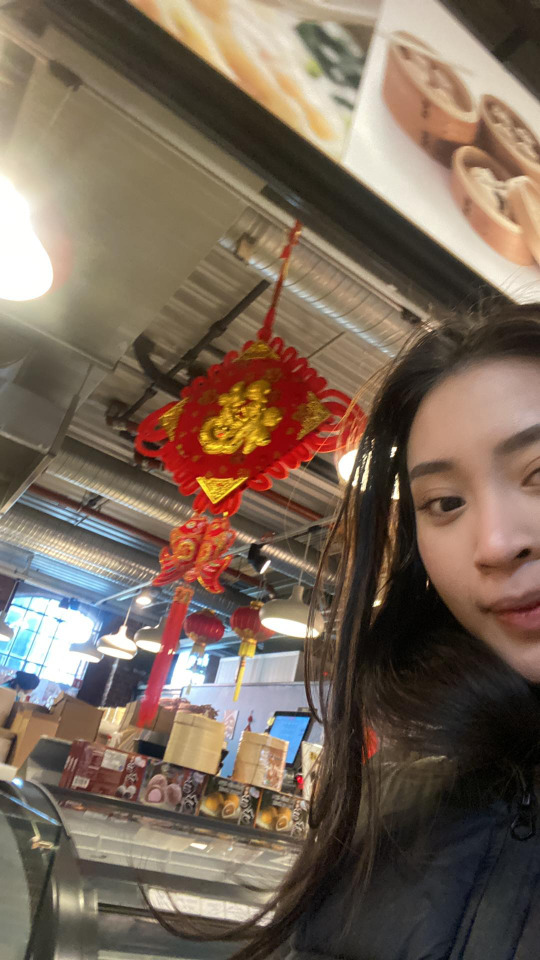
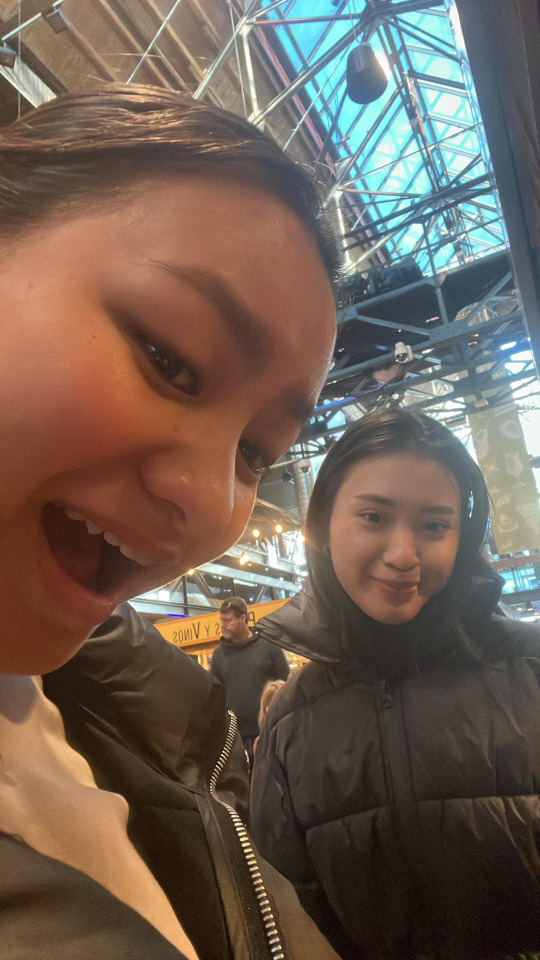
Playtesting 1.0
After a little bit of work, we finally tested our game! First on ourselves ofc, and then on some select few who were "unfortunate" enough to experience the first beta version. As expected, they experienced the same issues that we had noticed on our internal test.
Internal Playtest
Challenging to aim at the item while taking a selfie
Fun to look at the selfies afterwards
Competitive focus
Difficult to grab a photo of seating spots when occupied by strangers. Fun, easy and respectful to photograph signs and decorations instead. Maybe also photograph signs outside, so that the players can get some fresh air?
Useful to look at other player's images during the game, since you can guess where they're located, and use this information to sneak up on them. Or bait players out to snipe them instead, like Eva did.
Blurry images are fine as long as the target is identifiable.
Good that the players didn't run out of missions during the game.
Sounds: narrative adapted to the situation ("3D sound"). The app will make minimal amount of sound, because the game has a hide and seek aspect to it.
Should be at least 4 players at a time.
Some ideas
Make a map showing where the different missions are located?
Make missions easily accessible, so that the player doesn't have to scroll to the top of or otherwise scour the chat everytime they're about to decide on the next mission. Perhaps Snapchat's swipe function?
Maybe create some criterias for assassinations: Face, Selfie is extra point, no zooming, blurry is ok as long as the subject is identifiable.

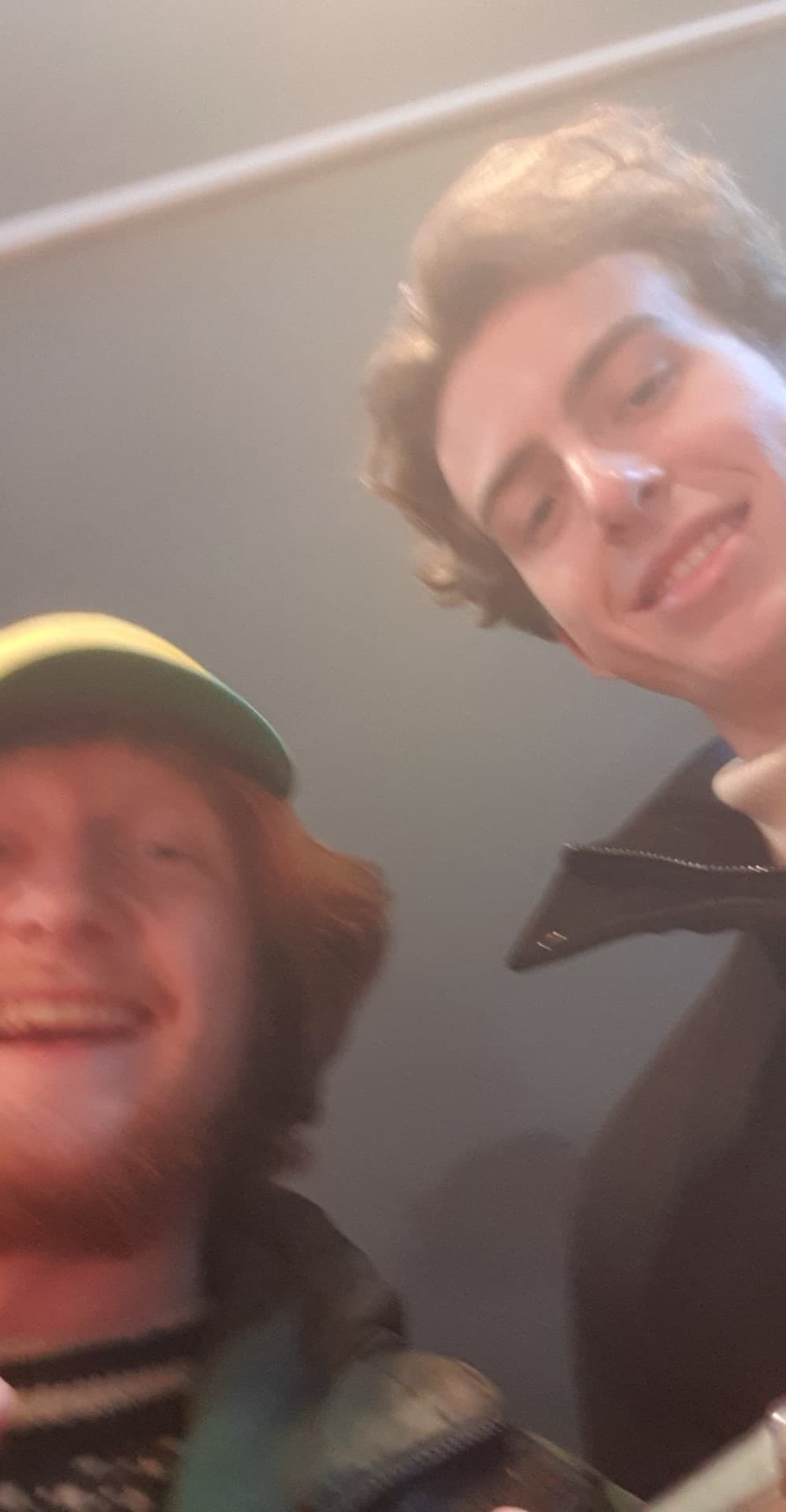
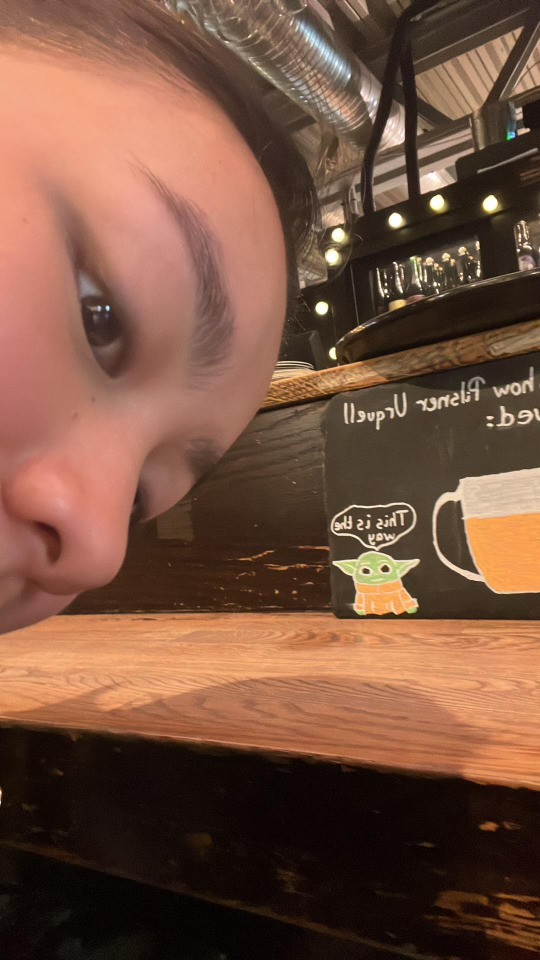
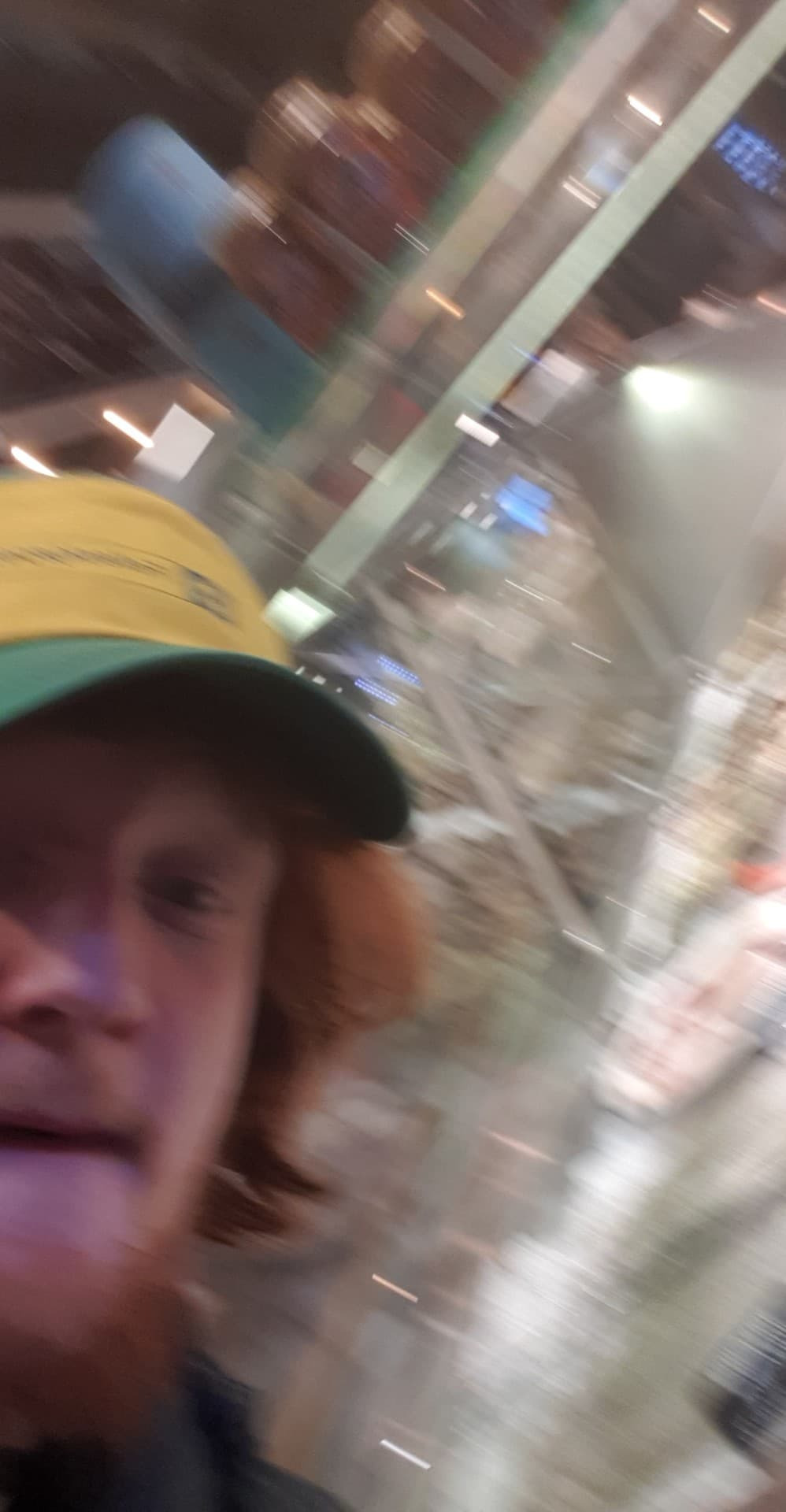
External playtest
No puzzles please. Be transparent about what we're looking for. Let's test this by actually showing an image of what the player is looking for.
Ideas for further development
Let's test with a GM next time (Game Master)
Let's test without taking a selfie, where the player can instead just make a gesture with their hand or finger.
Different levels: Let the player toggle the selfie rule on or off
Create a longer list of items for the player to find
Beginner or not?
Experience points
The players can decide the items themselves, by starting the game by photographing these items.
Group 9's game
Surprisingly, both our groups were among the few in class who had actually chosen the assassination genre, whereas the majority in class had chosen to go with an adventure-like game. So our rivals took us to Birkelunden where we got to experience a fun round of games. They used Snapchat instead of Facebook, which we used to snipe each other, hide. All the while looking for the clue which the GM had hidden before the start of the game.
Affiliates
Group 4: @designavva @paweetida @evahoybakk Thank you to @designerlarsprosjekter @plankedesign from group 9 who let themselves be subjected to the suffering that was version 1.0
#assassination game#playtest#test#ahoexploringinteractions2022#ahoexploringinteractions#brief 6#brief 6c#urban game#urban play#game design#pervasive games
5 notes
·
View notes
Text



Pitching session
Three ideas for urban play. Go!
Brainstorming
Starting out, we focused on figuring out some fun game mechanics we could work with, while visual identity and narrative would come second in our priorities. All three of our pitches may belong to vastly different genres of urban play, but they all centre around the same core game mechanic: the smartphone camera. Despite only choosing one of the pitched ideas, we did try to incorporate elements of the other ideas as well.
Idea #1: Assassination genre
First, an elaborate game of tag with campus students as the target demographic. In our incarnation of the assassination genre, players either play as a part of a faction or in a free-for-all (battle royale style) where they go around the site hunting down designated items as ordered by the GM (Game Master); Simultaneously the players hunt down their target, while trying to avoid being detected and assassinated themselves. The assassination targets circulate in a food chain pattern, as seen in the diagram below. Because of the assassination aspect, the game would inherently be a multiplayer experience requiring around 3-5 players.
Each mission will reward the player with points, depending on how challenging it was to find the item, and the player will lose points if they're photo sniped by another player. As for sounds, we were thinking of some UI sounds like when the player gains points, or when they're about to leave the playground site. The ideal location would be a crowded place with several nooks and niches to hide in, and plenty of items to discover and browse among, like Karl Johan street. As for the assigned theme of time travel, our first thought were something along the lines of steampunk.
Keywords: Compete, Collect, Daring, Multiplayer, Campus students


Idea #2: Treasure hunt genre
Second, a treasure hunt where the players walk around the city completing photo challenges where they for instance need to copy the pose of a famous statue that they're next to, perform a certain activity or action at a specific spot, or get creative with expressing an assigned theme while interacting with their environments. These photos would then be collected like polaroids in a sort of customizable digital scrapbook which they can look back upon, and in this sense become a sort of time travel by reminiscing while looking at images of the past. In short, the collection of images becomes a digital time capsule.
An other variation on this concept would be to place different stamp stations at different destinations, which would be collected in a digital passport. This was inspired by how in Japan, it's not unusual to see stands at certain tube stations, museums and landmarks, of course protected under a roof or inside a building. Travelers can then add the site specific stamp to their notebook or passport, these stamps often being cute and reflecting the destination they're placed in. This is something we thought could be fun, since it's always a bit melancholic to look at the many blank pages in our passports despite having traveled a lot. Since we have to work with an app and a digital passport, instead of an actual stamp, we could use QR codes. The fun aspect of this is collecting stamps, the same way it's fun to collect figurines from a gachapon machine or collect Pokémon cards. Friends can also tip other players on where to find cool stamps.
Keywords: Collect, Reminisce, Friendship, Freedom, Enjoying life, Singleplayer, All ages

Idea #3: Urban adventure genre
Third, a walking tour where the players "travel back in time" by exploring historical landmarks in the city. Several different tours could be created around different themes, e.g. one about Oslo's industrial revolution where the player visits the different factories situated along the Aker river, and one about Kristianabohemen where the player might follow in the footsteps of famous Oslo dwellers like Henrik Ibsen or Edvard Munch, or be a fiction tourist where the player visits the different sites where Knut Hamsun's Sult is based in or where the TV series SKAM was filmed.
Upon reaching a destination, an audio file would begin playing prompting the player to check the app, which then could show them old photographs and films from the city's archive, and maybe a text telling them about the site. Along the way, there could also be placed NPCs with whom the player can interact with and learn how people back then lived, and in this way become a "time traveler", as inspired by open-air and city museums like Folkemuseet and Arbeidermuseet.
During the pitching session, the teacher said that we could develop this idea further by making a tour or tutorial that's incredibly boring suddenly or gradually devolve into something completely different. With this we could have a lot of fun with foreshadowing, irony, puns and other comedic means. This idea reminds me a little of the Stanley Parable.
Keywords: Relaxing, Inspiring, Wisdom, Enjoying Life, Learn, Explore, Go back in time, Singleplayer

Verdict
The jury has spoken, and they expressed the most interest for our first idea: the assassination game! Other classmates suggested having a look at shrinking the map size during the game, inspired by battle royale games like Fortnite or even films like the Hunger Games when they're chased to the center of the map by wolf-like enemies. In my opinion, the most interesting idea shared during the session, was to make the player's screen freeze for a few seconds when they've been assassinated.
Affiliates
Group 4: @paweetida @evahoybakk @designavva
#mind map#brainstorm#ahoexploringinteractions2022#ahoexploringinteractions#brief 6#brief 6c#urban game#urban play#game design#pervasive games
3 notes
·
View notes
Text
Brief 6: Paraphrased
A study technique I like to use to ensure I understand an assignment is to either translate the brief into another language, forcing me to truly analyse the different words used, or to simply paraphrase the brief so that it is as concise as possible while keeping different pedagogic and didactic theories in mind (Imsen, 2020).
This project is a part of the brand new module "Introduction to Playful Interaction" by Nadja Lipsyc, and is the third project called "Create & Expand". Personally, I like to dub this assignment "Urban play" for simplicity reasons. Now, the original brief does not have a list of evaluation criteria (No. vurderingskriterier), but I thought it could benefit from having one. I've also included some adjustments made to the brief during the course of the project period.
Brief
What is an urban playful experience? Other words that can be used are pervasive games, urban play or games, embodied play, etc. In Norwegian I would translate it to "lek / å leke", but unfortunately the English noun "play" is almost exclusively reserved for theatre. In this text I will be using this noun as I would use the Norwegian noun "lek".
Design an urban "play" with a screen companion designed in Figma. You will be organizing and hosting an event where you invite some classmates to test the first 15 minutes of your final iteration, and create a walkthrough video based on the event. You will then show the video to your class and present your project, without the help of presentation slides.
Use what you’ve learnt from board game design and your urban explorations. Consider both the individual player’s journey and the multiplayer interactions. Your process should be iterative, building up from internal and external playtests. The final playtest should display clear instructions for the players, a visual identity using Figma, a sense of fiction and a linear progression (one thing leads to another).
Your time should be spent on design, iteration and creating a clear experience companion using Figma. A lot of your time should be spent on site, with some minor check-ins and forums happening in the classroom.

Groups
You will be working in groups of 4-5 people, and each group will be assigned a theme:
Group 1-5: TIME TRAVEL
Group 6-10: CONSPIRACY
Group 11-15: MAGIC
Output Checklist
Host and organize your urban game / event (15 min)
A screen companion designed in Figma
Video that shows a linear walkthrough of your experience with minimum editing (max. 10 min)
Tumblr documentation of your process (paper prototype, sketches, playtests, and other process photos. To get your experience more clearly structured, spend a little time sketching a flowchart.)
You can spend up to 200kr per team for materials. Keep the receipts and the school will refund you.
Evaluation criteria
Because this is a group project, attendance is going to be very important. Make sure to communicate with your group.
Sound should be integrated either to your screen companion or the urban game itself.
Use what you have learnt from board game design (mechanics, actions, game types, pacing, board sketching, delivering instructions…) and your urban explorations.
Consider both the individual player’s journey and the multiplayer interactions.
Your process should be iterative, building up from internal and external playtests.
The game can be played within a 10 min walking distance of campus.
The final playtest should display … :
clear instructions for the players
a visual identity using Figma
a sense of fiction
a linear progression (one thing leads to another)
Make sure you stage your experience within 10 minutes walking of Aho.
The game should be playable: the players should be able to interact with the environment and the content with limited guidance from the designers.
The video should be a walkthrough, meaning that the camera should follow one player from the beginning of their experience (including receiving informations) to the end. You can either follow a player during the final play, or refilm the player’s journey during the afternoon. You will not be evaluated on your filming skills and editing should be minimal (cutting waiting or walking times for instance). You can add sound separately if the video is not understandable otherwise. (…) No preparation is expected: you should spend your time polishing your design and playtesting!
The Figma companion: This brief is not about making a digital experience to be played outside. The phone is a companion (meant to enhance, clarify or diversify the experience) that should translate the visual and narrative identity of your experience.
Don't forget to name your experience and create clear onboarding instructions. Your Figma first page should give us a little taste of your game's identity.
Program
Aim for every group member to contribute to early reflections on game mechanics, spatial design, visual design, sound design and narration.
02.03 Briefing: Teacher briefs the students on the project
03.03 Lecture: We've invited a guest lecturer who will be talking about sound design.
03.03 Pitching session: The class is divided among the three teachers at school, and each group will be presenting three ideas, which will be given feedback and discussed in a forum setting. No slides needed.
04.03 Internal Playtest: Test the game on yourselves / Make sure you have playtested internally at least once before you test it on others.
04.03 First External Playtests: Swap groups and playtest
08.03 Second External Playtests: Swap groups and playtest
09.03 General Check-in at school
09.03 Please comment the threads below with the main area/starting point of your experience ( cemetery, cuba park, etc) so we can try to avoid spatial overlaps.

10.03 Final Play & Filming: This is the last iteration of your playtests. You should take time the same day to film and edit fragments of your game.
We will go through the final plays from 10.00 in groups of 5 teams until lunch. Some games require more than 4 players and you might be asked to join in. If not, you will observe or prep for your own final play.
Please message me ASAP if something doesn't work for your team. We expect all teams in each group to be there at 10 outside of Aho (for Einar and Nadja's groups) and at 9.30 (for Hans Gerhard group), as you will either participate in the play, help filming or observe.

11.03 Screening & Comments: Screening of the short videos for the whole class. No presentation, no slides; Only verbal explanations and comments.
About the screening: your video shouldn't be longer than 10 minutes and you can talk while showing us the images. We will then ask you simple questions, so no need to prepare for it.
Upload your films here: https://ahocloud.app.box.com/f/e20690892a994a92a323c8421e596eb5
11.03 Module Feedback. Thank you all for some creative and ingenious 3 weeks. Here is a link to an anonymous feedback form. No need to write a lot or to answer all the questions: one sentence here and there will already be useful. Enjoy Sound Design and electronics work and keep in touch! 📷
https://forms.gle/4SFgijg8U9zt9pzJ8 Due in a week.
Readings and Resources
Encyclopedia of Mechanisms. You can still refer to this tabletop game design encyclopedia to find inspiration for game mechanics.
Pervasive Games. Look up other types of spatial and embodied games in this book.
Pattern-seekers drift. … or get inspiration from these prompts.
Urban play chart. This is the digital version of today’s instructions.
Collaboration & Playtesting checklist. Teamwork and playtesting require communication and a bit of anticipation. Make sure you go through the collaboration checklist with your group and use the playtest checklist to prepare for your playtest.
Recommendations
A great series about an ARG with many good design ideas https://www.youtube.com/watch?v=mQq0WWRjL9E
ECHOES: Geolocated audio tours and experiences.
An example of simple flowchart for game design. This is meant for digital games, but the linearity of interactions still applies! https://mrstromain.wordpress.com/flowcharts/
Although sketching it on paper will already give you everything you need, here's a figma plugin for flowcharts https://www.figma.com/templates/flowchart-maker/
#didactics#oppgaveformulering#ahoexploringinteractions2022#ahoexploringinteractions#brief 6#brief 6c#urban game#urban play#game design#pervasive games
1 note
·
View note